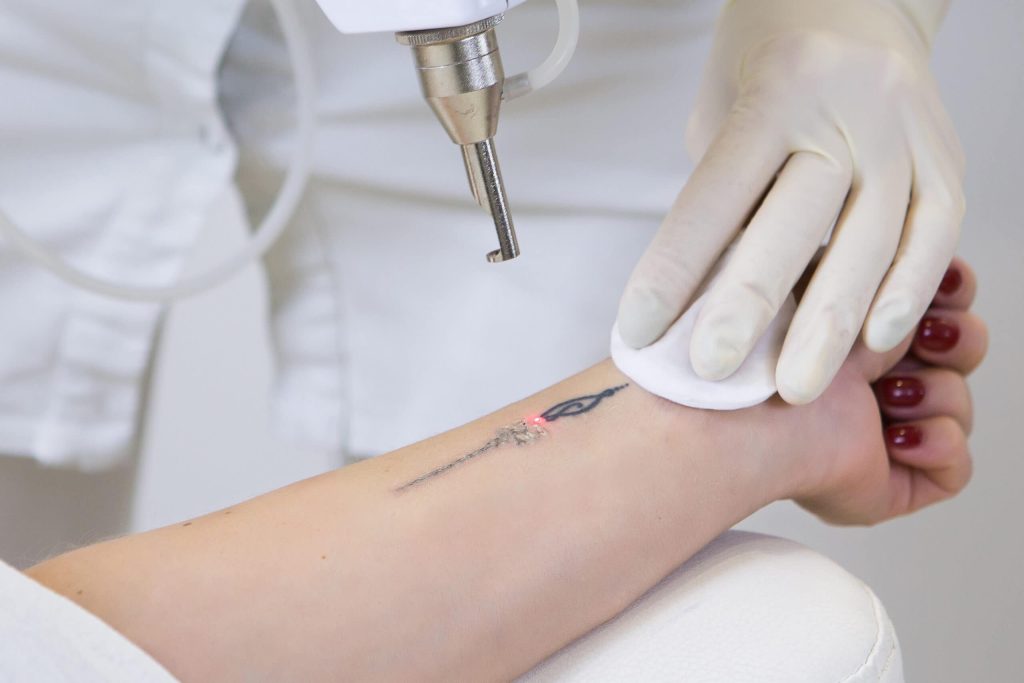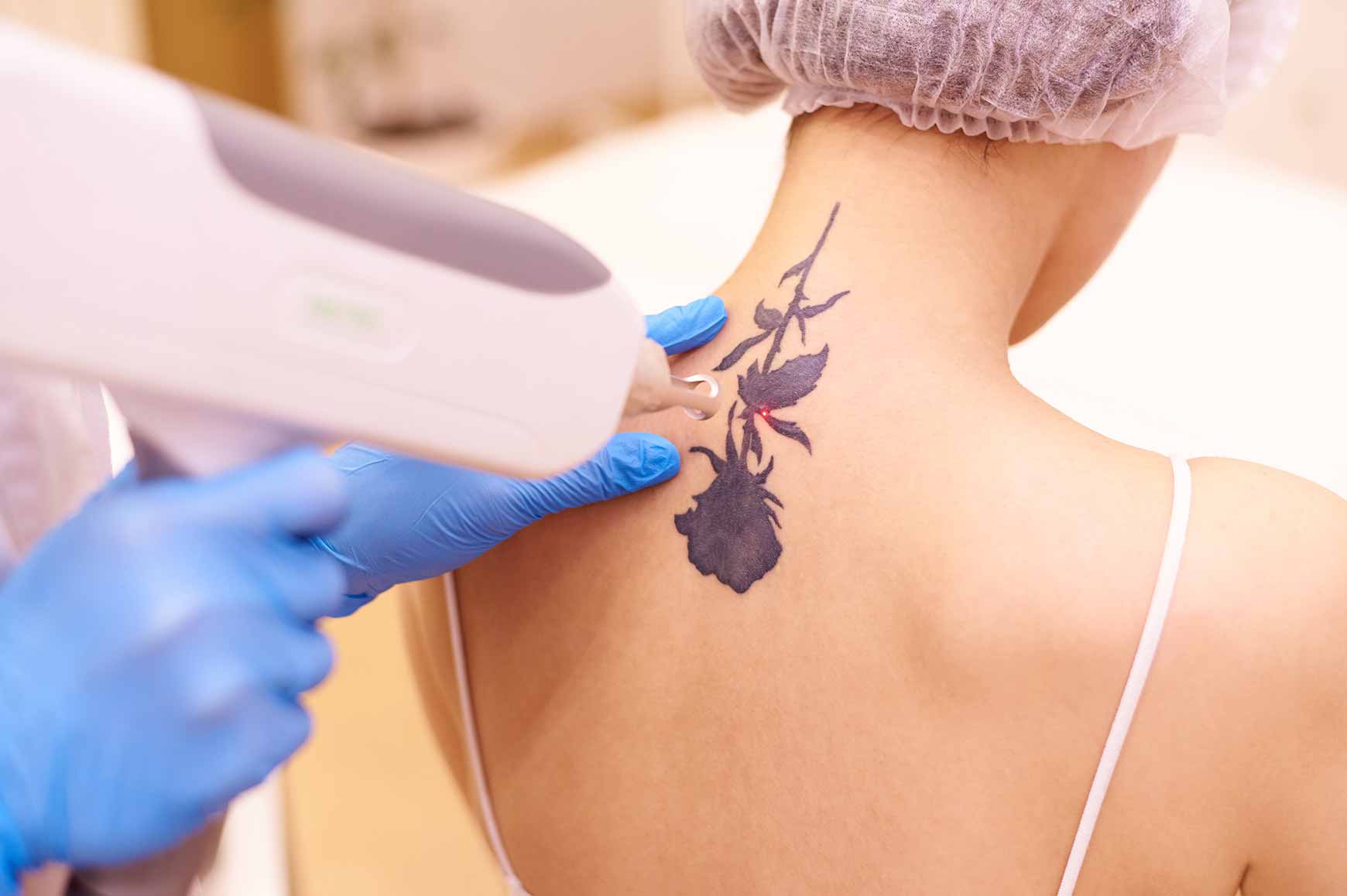Laser tattoo removal is a game-changer for anyone wanting to lighten troublesome tattoos, erase cosmetic tattoos, or remove multicolored tattoos from their skin. It offers a safe and effective way to remove unwanted tattoos without the pain of traditional methods. Many people find themselves regretting their unwanted tattoo choices as time passes, leading to a desire for significant tattoo clearing and effective tattoo removal services in the tattoo process.
This innovative procedure uses advanced technology to break down tattoo pigments, allowing your body to naturally eliminate them. Whether it’s an ex’s name or a design that no longer resonates, laser tattoo removal can help you reclaim your skin. Discover how this laser tattoo removal session process works and what you can expect as you take the first step toward a clean slate using various tattoo removal techniques and methods for fragmenting tattoo pigment particles.
Understanding Laser Tattoo Removal
Definition
Laser tattoo removal is a medical procedure that uses lasers to break down the ink in tattoos. The laser emits light energy that targets the tattoo pigment. This energy causes the ink particles in the tattoo removal process to fragment into smaller pieces. The body’s immune system then gradually removes these particles over time.
Targeting Ink
The process specifically focuses on fragmenting tattoo pigment particles in the ink while protecting the surrounding skin. Lasers can be adjusted to different wavelengths. This allows for precise targeting of various ink colors. The surrounding tissue remains unharmed, fragmenting tattoo pigment particles and reducing the risk of scarring or other skin damage.
Treatment Factors
Several factors affect how effective laser tattoo removal will be. These include the age of the tattoo, its size, color, and the type of skin involved.
-
Tattoo Age: Older tattoos are generally easier to remove. The ink fades naturally over time, making it less dense.
-
Tattoo Size: Larger tattoos take more sessions to remove than smaller ones. Each session targets a specific area, so larger designs require more time.
-
Tattoo Color: Different colors absorb laser light differently. Black ink absorbs all wavelengths well, making it easier to remove. Colors like green and yellow can be harder to target effectively.
-
Skin Type: Skin tone plays a role too. Lighter skin tones respond better to laser treatments because there is less contrast between the skin and the ink.
Procedure Steps
-
Consultation: A consultation with a qualified professional is necessary before starting treatment. They assess the tattoo and discuss expectations.
-
Preparation: The area around the tattoo is cleaned and may be numbed with a topical anesthetic.
-
Laser Application: The laser is applied in short bursts to minimize discomfort. Patients may feel a slight sting during this phase.
-
Aftercare: After treatment, care instructions are provided. These usually involve keeping the area clean and protected from sun exposure.
Session Frequency
Sessions are typically spaced several weeks apart. This gives the body time to heal and for the immune system to eliminate the broken-down ink particles. Most people need multiple sessions for complete removal, depending on their specific circumstances.
Risks and Considerations
While generally safe, some risks exist. Side effects can include redness, swelling, and temporary changes in skin color. It’s crucial to follow aftercare instructions closely to minimize these risks.
Safety of Laser Tattoo Removal
Professional Consultation
Consulting with a trained professional is crucial before undergoing laser tattoo removal. Experts assess your tattoo and skin type to determine the best approach. They explain the procedure and potential risks involved. A thorough consultation helps set realistic expectations. It also ensures that you understand what to expect during and after the treatment.
Trained professionals can identify any underlying skin conditions that may affect the outcome. They can also recommend alternative methods if laser removal is not suitable for you. This personalized assessment is essential for ensuring safety and effectiveness.
FDA-Approved Lasers
Safety in laser tattoo removal largely depends on the technology used. Only FDA-approved lasers should be utilized for this procedure. These lasers are tested for safety and efficacy. They minimize the risk of adverse effects compared to non-approved devices.
Different types of FDA-approved lasers target various ink colors effectively. For instance, Q-switched lasers can remove black, blue, and green inks efficiently. Understanding which laser is appropriate for your tattoo can significantly impact the results.
Using approved lasers ensures that treatments adhere to established safety standards. This reduces the chances of complications during the process. Always ask your provider about the specific type of laser they use.
Aftercare Importance
Proper aftercare following laser tattoo removal plays a vital role in recovery. Following treatment, the skin may be sensitive and prone to infection. Keeping the area clean and moisturized is essential. Avoiding sun exposure helps prevent pigmentation changes.
Patients should follow their provider’s aftercare instructions closely. This might include applying ointments or avoiding certain activities for a few days. Neglecting aftercare can lead to complications such as scarring or infection.
Infections can occur if bacteria enter through broken skin post-treatment. Signs of infection include increased redness, swelling, or discharge from the treated area. If any symptoms arise, contact your healthcare provider immediately.
Risks and Considerations
While laser tattoo removal is generally safe, some risks still exist. Common side effects include temporary redness and swelling at the treatment site. Some individuals may experience blistering or changes in skin texture.
Understanding these risks allows patients to make informed decisions about their care. Discussing concerns with a qualified professional helps address any fears before starting treatment.
Types of Laser Treatments
Q-Switched Lasers
Q-switched lasers are the most commonly used for tattoo removal. They work by emitting short bursts of high-energy light. This energy targets the ink particles in the skin. The laser breaks down the ink into smaller pieces. The body can then absorb these smaller particles more easily.
These lasers are effective for a variety of tattoo colors. They work well on darker inks, such as black and blue. Studies show that Q-switched lasers can significantly fade or remove tattoos after several sessions. Most patients need multiple treatments to achieve desired results, typically spaced six to eight weeks apart.
Picosecond Lasers
Picosecond lasers represent a newer technology in tattoo removal. They operate with even shorter pulses than Q-switched lasers. This allows them to break down ink particles more efficiently. As a result, picosecond lasers can reduce treatment times.
Research indicates that picosecond lasers may require fewer sessions compared to traditional methods. Patients often see quicker results, which can be appealing. These lasers also minimize skin damage, leading to less recovery time.
Ink Color Considerations
Different types of lasers target various ink colors effectively. For example, certain wavelengths work better for specific colors. Red ink often responds well to green wavelengths, while blue and black inks respond better to different settings.
Skin type also plays a crucial role in selecting the right laser treatment. Lighter skin tones generally have better outcomes with laser treatments due to higher contrast with the ink. Darker skin tones may require special considerations to avoid damage.
Practitioners assess both ink color and skin type before beginning treatment. This personalized approach ensures the best possible results while minimizing risks.
Treatment Sessions
Laser tattoo removal is not a one-time process. Patients typically undergo multiple sessions for complete removal. Each session lasts about 15 to 30 minutes, depending on the tattoo size and complexity.
After each session, some redness and swelling may occur but usually subsides quickly. Following proper aftercare is essential for optimal healing and results.
The Laser Tattoo Removal Process
Initial Consultation
A laser tattoo removal procedure begins with an initial consultation. During this meeting, the dermatologist evaluates the tattoo. They consider factors like size, color, and pigment density. This helps them determine the best approach for your specific tattoo. You will also discuss your medical history and any skin conditions. This information allows the dermatologist to assess potential risks.
Preparation Steps
Cleaning the skin is the first step in the tattoo removal process. The area around the tattoo is washed thoroughly. This reduces the risk of infection during the procedure. After cleaning, the dermatologist applies a numbing cream to minimize discomfort. This cream usually takes about 30 minutes to take effect. Once numb, they proceed with the laser treatment.
Laser Application
The next step involves using a specialized laser. Different lasers target various colors of tattoo pigment. For instance, Q-switched lasers are common for their effectiveness on darker inks. The laser emits light that breaks down the tattoo pigment in the skin. As a result, the body can gradually absorb and eliminate these particles over time.
Multiple Sessions Required
Complete removal often requires multiple tattoo removal sessions. Most people need between 5 to 10 sessions, depending on factors like tattoo age and pigment density. Each session is spaced about 6 to 8 weeks apart to allow healing. After each session, you may notice your tattoo gradually lightening.
Aftercare Instructions
After a laser tattoo removal session, proper aftercare is essential. The treated area may be red or swollen initially. Keeping it clean and applying any prescribed ointments helps speed up recovery. Avoiding sun exposure is crucial as UV rays can affect healing.
Alternative Methods
e individuals explore alternative methods for tattoo removal, such as excision or dermabrasion. Excision involves cutting out the tattooed skin, while dermabrasion sands down the skin layers. However, these methods may leave scars and are not as commonly recommended as laser treatments.
Pain and Side Effects
Discomfort Level
The laser tattoo removal procedure can be uncomfortable. Many people report a sensation similar to a rubber band snapping against the skin. Numbing agents are often used to help manage this discomfort. These agents can significantly reduce pain during the treatment.
Common Side Effects
After the procedure, some common side effects occur. Soreness is typical in the treated area. Swelling and redness may also appear. These reactions usually last for a few days, but they should gradually subside.
Post-Treatment Care
Proper care after the procedure is essential. Using an ice pack on the treated area can help alleviate swelling and soreness. Apply the ice pack for about 10-15 minutes at a time. This method cools down the skin and reduces inflammation.
Over-the-counter pain relief can also be beneficial. Medications like ibuprofen or acetaminophen can ease discomfort. Always follow the recommended dosages on the packaging.
Blisters Formation
e people may experience blisters after treatment. Blisters form as part of the body’s healing process. They act as a protective barrier for the underlying skin. It’s important not to pop these blisters, as this can lead to infection.
If blisters do occur, keep the area clean and dry. Applying a gentle antibiotic ointment can help prevent infection. Consult with your healthcare provider if you notice signs of infection, such as increased redness or pus.
Healing Timeline
Healing times vary among individuals. Most people see significant improvement within a few weeks. However, complete healing may take longer depending on various factors, including skin type and tattoo size.
It’s crucial to follow all aftercare instructions provided by your technician. Adhering to these guidelines ensures optimal healing and minimizes side effects.
Emotional Impact
The emotional aspect of tattoo removal should not be overlooked. Many people feel anxious about how their skin will look post-treatment. It’s important to remember that side effects are temporary. Most individuals find that their skin heals well over time.
Support from friends or family can help ease anxiety during recovery. Sharing experiences with others who have undergone similar procedures can also provide comfort.
Post-Treatment Care
Cleanliness Importance
Keeping the treated area clean is crucial. Proper hygiene helps prevent infection and promotes healing. Patients should gently wash the area with mild soap and water. Avoid scrubbing or using harsh chemicals. After cleaning, apply an antibiotic ointment as recommended by the provider. This ointment protects the skin and aids in recovery.
Regularly changing the bandage is also important. It keeps the area covered and reduces exposure to dirt. Bandages should be replaced whenever they become wet or dirty. This simple step can significantly lower the risk of complications.
Bandage Recommendations
Wearing a bandage after treatment is essential for protection. It shields the skin from external irritants. Patients should use a sterile bandage to cover the treated area. This reduces the chances of contamination.
Avoiding tight clothing is also recommended. Tight fabrics can rub against the skin, causing irritation. Loose-fitting clothes allow the skin to breathe, which is beneficial for healing.
Sun exposure can harm sensitive skin post-treatment. Avoid direct sunlight on the treated area for at least four weeks. If sun exposure is unavoidable, apply a high-SPF sunscreen to protect it.
Infection Monitoring
Monitoring the treated area for signs of infection is vital. Look for symptoms such as increased redness, swelling, or pus. These signs may indicate an infection that needs immediate attention.
If any unusual changes occur, contact the provider promptly. Early intervention can prevent more serious issues down the line. Regular follow-ups with the treatment provider are also advisable. They can assess healing progress and address any concerns.
Following these care guidelines supports effective recovery after tattoo removal treatments. Proper care minimizes side effects and enhances results from laser procedures.
Number of Sessions Needed
Tattoo Characteristics
The number of sessions needed for laser tattoo removal varies. Factors include the tattoo’s size, color, and age. Each tattoo is unique, which influences how it responds to treatment.
Older tattoos often fade more easily than newer ones. They usually require fewer sessions for complete removal. Smaller tattoos also tend to need less time in treatment. Their limited ink coverage makes them easier to target.
Skin Type
Skin type plays a crucial role in the number of sessions required. Lighter skin tones generally respond better to laser treatments. The contrast between the skin and the ink allows for better targeting by the laser. Darker skin tones may require additional sessions due to increased risk of pigmentation changes.
A consultation with a professional can help determine how many sessions will be necessary. They assess the tattoo characteristics and individual skin type during this meeting.
Professional vs. Amateur Tattoos
Professional tattoos often have more ink and multiple colors. These tattoos can take longer to remove compared to amateur tattoos. The presence of various colors means that different wavelengths of laser light are needed for effective treatment.
Each color may require its own specific setting on the laser device. This complexity can lead to an increase in the total number of sessions needed for removal.

Treatment Plan
After the initial consultation, a treatment plan is developed. This plan includes estimates on how many sessions will be required based on the earlier assessments.
Typically, patients undergo treatments spaced about 6-8 weeks apart. This spacing allows the skin to heal properly between sessions.
During follow-up appointments, progress is evaluated. Adjustments to the treatment plan can be made if necessary. Some patients may notice significant fading after just a few sessions, while others may need more time.
Emotional Considerations
Removing a tattoo can be an emotional process for many people. Individuals often seek this procedure due to changes in personal circumstances or regrets about past decisions. Understanding that multiple sessions may be needed helps set realistic expectations.
Patients should prepare for this journey both physically and emotionally. Support from friends or family can be beneficial during this time.
Alternative Tattoo Removal Methods
Surgical Excision
Surgical excision is a tattoo removal method for small tattoos. This procedure involves cutting out the tattooed skin and stitching the remaining skin together. It can provide complete tattoo removal in one session. However, it is best suited for smaller designs.
The recovery time after surgical excision can be longer than other methods. Patients may experience pain and swelling. Scarring is also a significant concern with this technique. Proper aftercare is essential to minimize complications.
Dermabrasion
Dermabrasion is another option for removing unwanted tattoos. This technique uses a rotating device to sand down the outer layers of skin. The goal is to remove the ink embedded in the skin.
While dermabrasion can lead to successful tattoo removal, it has its drawbacks. It often requires multiple sessions for effective results. Patients may experience redness and irritation during recovery. Like surgical excision, this method can also result in scarring.
Home Tattoo Removals
Home tattoo removals are becoming popular due to their convenience. Various tattoo removal kits are available on the market. These kits often include creams and ointments designed to fade tattoos over time.
However, home treatments may not be as effective as professional options. Results vary widely among users. Some people report minimal fading, while others see no change at all. These methods can also cause skin irritation or allergic reactions.
Tattoo Removal Creams and Ointments
Tattoo removal creams claim to lighten or remove tattoos without surgery. They contain ingredients that penetrate the skin and break down ink particles. While some users find success with these products, many dermatologists remain skeptical.
The effectiveness of these creams varies significantly from person to person. Some individuals may experience side effects such as rashes or burns. Users should approach these products with caution and consult professionals if unsure.
Drawbacks of Other Methods
Many alternative tattoo removal procedures come with drawbacks. Scarring is a common issue across various techniques, including surgical excision and dermabrasion. Longer recovery times can also deter individuals from choosing these methods.
Patients must weigh the pros and cons before deciding on a treatment plan. Consulting a dermatologist can help identify the most suitable option based on individual needs and tattoo size.
Effectiveness of At-Home Solutions
Risks of DIY Creams
Many people consider using DIY tattoo removal creams. These products promise quick results. However, they often lack FDA approval. This means their safety and effectiveness are not guaranteed. Using these creams can lead to skin irritation or serious damage. Some users have reported burns and scarring. It’s essential to recognize the risks involved in these at-home methods.
Limited Effectiveness
At-home tattoo removal methods are generally less effective than professional treatments. Many users find that these solutions do not work as advertised. Creams may lighten tattoos slightly, but they rarely remove them completely. This can lead to frustration and disappointment. Professionals use advanced techniques like laser therapy, which targets ink particles more effectively.
Professional Consultation Recommended
Consulting with a professional is the best option for tattoo removal. Experts assess the tattoo’s size, color, and age before recommending a treatment plan. They use safe and proven methods that minimize skin damage. A consultation ensures you receive personalized advice tailored to your needs.
Summary
Laser tattoo removal is your go-to solution for erasing unwanted ink safely and effectively. Understanding the process, types of lasers, and aftercare can make all the difference in your journey to clear skin. You’ve learned about pain levels, side effects, and how many sessions you might need. Plus, you now know the alternatives that exist if laser isn’t your thing.
Taking the plunge into tattoo removal is a big step. Trust in the expertise of professionals to guide you through it. Embrace the benefits of laser technology and say goodbye to regrets. Ready to start your journey? Reach out to a certified specialist today and take control of your skin!
Frequently Asked Questions
What is laser tattoo removal?
Laser tattoo removal uses concentrated light beams to break down ink particles in the skin. This method effectively fades or eliminates unwanted tattoos, making it a popular choice for many.
Is laser tattoo removal safe?
Yes, when performed by a qualified professional, laser tattoo removal is generally safe. Side effects are minimal and can include temporary redness or swelling.
How many sessions are needed for complete removal?
The number of sessions varies based on tattoo size, color, and skin type. Most people require between 5 to 10 sessions for optimal results.
Does laser tattoo removal hurt?
Patients often describe the sensation as similar to a rubber band snapping against the skin. Local anesthesia can be used to minimize discomfort during the procedure.
Are there any side effects?
Common side effects include redness, swelling, and blistering. These usually resolve within a few days. Following post-treatment care can help reduce these effects.
Can I remove my tattoo at home?
At-home solutions are generally less effective and can cause skin damage. Professional treatments offer safer and more reliable results for tattoo removal.
How does post-treatment care work?
Post-treatment care includes keeping the area clean, avoiding sun exposure, and applying recommended ointments. Proper care aids healing and enhances the effectiveness of the treatment.





